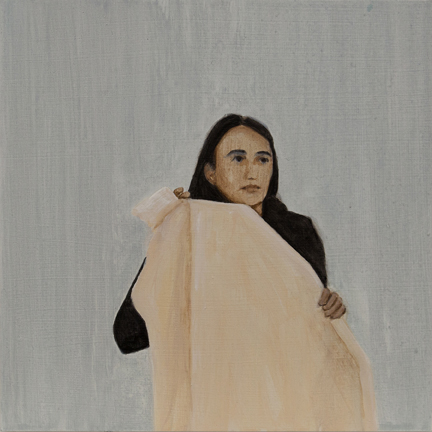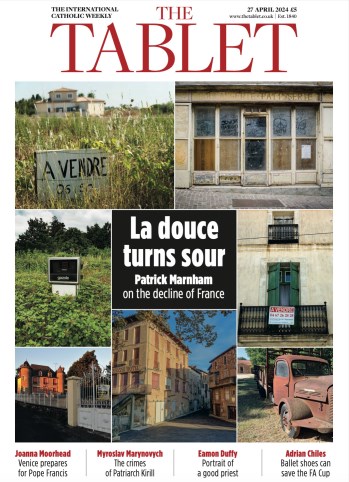 It is not hard to see how religion and contemporary art might hold each other in tolerant disdain. For many believers, contemporary art – having given up on the pursuit of beauty and truth – is considered the decadent wing of secularism. On the other hand, many artists believe that religious iconography – having lost any cultural traction in a secular age – has retreated into the realm of the kitsch. I wanted to test these positions.
It is not hard to see how religion and contemporary art might hold each other in tolerant disdain. For many believers, contemporary art – having given up on the pursuit of beauty and truth – is considered the decadent wing of secularism. On the other hand, many artists believe that religious iconography – having lost any cultural traction in a secular age – has retreated into the realm of the kitsch. I wanted to test these positions.
Early on, I decided that any dialogue between faith and contemporary art would require a subject matter broad enough to embrace a variety of viewpoints. I wanted to fix the conversation in an unashamedly Christian context so that it did not float off into some spiritual stratosphere, and the tradition of the Stations of the Cross appeared to offer the imaginative scope for a mature exchange of ideas.
I met the artist Robert Priseman for lunch, and towards the end of our meal, I ambushed him with the question: “Can you find me 14 painters to create a new Stations of the Cross for Brentwood?” He took a mouthful of coffee and replied: “Of course, leave it to me.”
Within 48 hours, I had not 14, but 15 of the finest living British painters signed up for the project, artists who had work both in major public and private collections. Drawn from across the country, they included some with a degree of religious belief and some with none. Each was given the title of a Station together with an identical blank 12-inch square aluminium panel. They were completely free to respond to their allocated subject in whatever way they chose. The risk was that some artists might use their paintings for ideological purposes seeking to ridicule belief. But they didn’t, and individual works exhibited a respect for the seriousness of the subject matter.
The first Station, Jesus is Condemned to Death, by David Ainley, eschews pious illustration in favour of an image saturated with possible meanings. Ainley has created a chalky-white picture plane etched with vertical grooves. A simple cross cut from the support has been slotted, rather like a jigsaw piece, back into the painting. The monochrome surface could be thought of as symbolising the blank mental response of the condemned Jesus. The cross could be either a kiss or a sign that something needs to be erased, or even possibly the X factor of someone special. Thus, Ainley builds up a picture of Christ through associations.
The sign of the Cross appears as a visual leitmotif in many of the Stations. Sometimes it acts as a strong geometric form bearing the weight of abstract ideas, as in Pen Dalton’s Jesus Falls the Second Time where the Cross fixes an ill-defined human form. In other works, it becomes a theological hieroglyph. Ruth Philo’s tenth station, Jesus is Stripped of his Garments, dissolves the image back to almost nothing and we are left with a pink fleshy hue etched with scratch marks. This is a death of a thousand nicks and cuts, a violence that is at once both subtle and brutal.
Other artists have decided to focus on physical detail. Robert Priseman’s Jesus is Nailed to the Cross isolates two iron nails. Using recent archaeological evidence, Priseman paints them to the actual size of nails found in crucified bodies. Without resorting to torture-porn images, this Station’s understated account of the physical sadism that Christ endured moves the viewer to compassion. London-based artist Matthew Krishanu hones in on the textile used by Veronica – the proto image-maker of Christ – to wipe the face of Jesus. Krishanu freezes the moment of doubt experienced by those who try to capture an image of Christ.
Artists who make no claim to a personal faith have inevitably approached their Station through the lens of their own absence of religious conviction. Andrew Crane uses plaster, kindling and oil paint to sculpt a response to his title, Simon of Cyrene Helps Jesus Carry the Cross. Crane has broken a piece of wood and then fixed it to the picture plane. For him, this resonates with the words of Jesus quoted in the Gospel of Thomas: “Split a piece of wood; I am there.”
David Sullivan sees in his station, Jesus Falls for the Third Time, universal resonances: “Falling Christ, forced to the ground under the weight of his Cross, is a powerful metaphor for humanity’s descent towards despair.”
Both the presence and the absence of the divine are recurring motifs in these works. Alex Hanna finds in an empty pill packet a symbol that communicates the event of Jesus Being Laid in the Tomb. At one level, this is an image of an object that no longer has any value. However, Hanna invites us to look beyond the utilitarian and to meditate on it as a visual metaphor for the Wounded Healer. In Simon Carter’s fifteenth station, Jesus Rises from the Dead, a faceless figure stands square on to us. We know it is meant to be Jesus, but we inevitably struggle to recognise him. In this failure, we experience something of the same uncertainty of those disciples who first encountered the risen Christ.
The artists who created the Brentwood Stations of the Cross have approached this challenge with the same creative openness and intellectual rigour that they would apply to any other subject. The question now is: can the believers who encounter these images during the season of Lent manage to do the same?
View all the images here.



 Loading ...
Loading ...
What do you think?
You can post as a subscriber user...
User Comments (3)
I was most disappointed and dismayed to see that the titles of these paintings were from the list of Stations which I thought, and hoped, were now obsolete. Why are they not from the renewed list of stations instituted by the Congregation of the Liturgy about a dozen years ago, under the influence of Vatican II reforms - 14 or 15 incidents taken from the Gospels, rather than from mythology, such as Veronica and Jesus falling 3 times? Biblical stations have been used by Popes JP II ad Benedict XVI, and have been featured at World Youth Days throughout the world. Is Brentwood stuck in out-dated, pre-Vatican thinking?
I take it that Fr Boland's new Stations of the Cross at Brentwood cathedral are merely on exhibition.The existing Stations are by Raphael Maklouf.Their timeless,classical style is in harmony with Bishop Thomas McMahon's and architect Quinlan Terry's designs for the cathedral (1989-1991).
Having looked at the illustrations I fear they may well be a distraction instead of an aid to prayer, as worshippers' attention focuses on understanding 'artistic messages' rather than a spiritual encounter with the Way of the Cross.